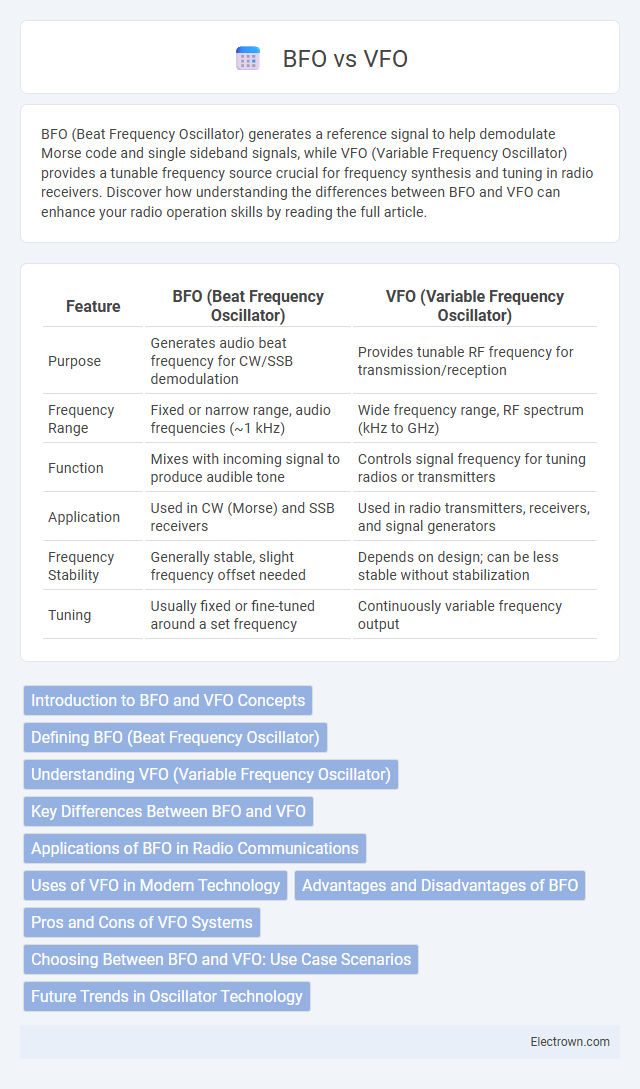BFO (Beat Frequency Oscillator) generates a reference signal to help demodulate Morse code and single sideband signals, while VFO (Variable Frequency Oscillator) provides a tunable frequency source crucial for frequency synthesis and tuning in radio receivers. Discover how understanding the differences between BFO and VFO can enhance your radio operation skills by reading the full article.
Table of Comparison
| Feature | BFO (Beat Frequency Oscillator) | VFO (Variable Frequency Oscillator) |
|---|---|---|
| Purpose | Generates audio beat frequency for CW/SSB demodulation | Provides tunable RF frequency for transmission/reception |
| Frequency Range | Fixed or narrow range, audio frequencies (~1 kHz) | Wide frequency range, RF spectrum (kHz to GHz) |
| Function | Mixes with incoming signal to produce audible tone | Controls signal frequency for tuning radios or transmitters |
| Application | Used in CW (Morse) and SSB receivers | Used in radio transmitters, receivers, and signal generators |
| Frequency Stability | Generally stable, slight frequency offset needed | Depends on design; can be less stable without stabilization |
| Tuning | Usually fixed or fine-tuned around a set frequency | Continuously variable frequency output |
Introduction to BFO and VFO Concepts
BFO (Beat Frequency Oscillator) and VFO (Variable Frequency Oscillator) serve crucial roles in radio communication and signal processing. BFO generates a fixed frequency used to mix with incoming signals, enabling the detection of Morse code or single sideband signals, while VFO offers adjustable frequency output to tune and stabilize the desired signal. You benefit from understanding these oscillators to optimize radio reception and transmission performance.
Defining BFO (Beat Frequency Oscillator)
BFO (Beat Frequency Oscillator) is an electronic circuit used in radio receivers to make Morse code and single sideband (SSB) signals audible by generating a frequency that mixes with the received signal. This process creates an audible beat frequency, allowing you to hear signals that are otherwise inaudible due to their lack of a carrier tone. The BFO is essential in applications involving CW (continuous wave) and SSB transmission modes.
Understanding VFO (Variable Frequency Oscillator)
A Variable Frequency Oscillator (VFO) generates adjustable frequencies within a specific range, allowing radio operators to fine-tune signals for communication or signal processing. Unlike a Beat Frequency Oscillator (BFO) that produces a fixed frequency to mix with incoming signals for demodulation, a VFO offers flexibility by continuously varying its output frequency. VFOs are essential in amateur radio transmitters and receivers, providing precise control over carrier frequency and enabling frequency modulation and tuning across multiple bands.
Key Differences Between BFO and VFO
BFO (Beat Frequency Oscillator) generates a fixed frequency signal used mainly to make Morse code and single sideband signals audible by creating an audible beat frequency when mixed with the incoming signal. VFO (Variable Frequency Oscillator) provides a tunable frequency output, allowing precise adjustment across a broad frequency range for tuning various signals. Your radio receiver uses a VFO to select stations, while a BFO enhances the demodulation of certain types of transmissions, highlighting their distinct functional purposes.
Applications of BFO in Radio Communications
BFO (Beat Frequency Oscillator) is primarily used in radio communications to demodulate Morse code (CW) and Single Sideband (SSB) signals by mixing with the incoming signal to create an audible tone, enabling clear reception. Its application is crucial in amateur radio, military communication, and shortwave listening, where accurate decoding of weak or encrypted transmissions is necessary. Your radio receiver benefits from BFO for improved signal clarity when dealing with continuous wave and sideband modes.
Uses of VFO in Modern Technology
Variable Frequency Oscillators (VFOs) are essential in modern communication systems, enabling precise tuning across a wide range of frequencies in radios and transceivers. Their ability to provide stable and adjustable frequencies makes them critical for applications such as signal generation, frequency modulation, and synthesizers in mobile devices and software-defined radios. VFOs enhance the flexibility and performance of wireless technologies, supporting dynamic frequency allocation and interference avoidance in congested signal environments.
Advantages and Disadvantages of BFO
The Beat Frequency Oscillator (BFO) offers distinct advantages including improved demodulation of single sideband (SSB) and Morse code signals by providing a stable reference frequency, enhancing signal clarity. However, BFOs can introduce unwanted noise and interference, making them less effective in crowded or weak signal environments. They are generally simpler and more cost-effective than Variable Frequency Oscillators (VFO), but lack the frequency agility and precision control provided by VFOs in modern communication systems.
Pros and Cons of VFO Systems
VFO (Variable Frequency Oscillator) systems offer precise frequency tuning flexibility, making them ideal for applications requiring rapid frequency adjustments and broad frequency coverage. However, their complexity and susceptibility to frequency drift can lead to stability issues compared to fixed-frequency oscillators. Understanding these pros and cons helps you choose the right system for your signal generation needs, balancing versatility with reliability.
Choosing Between BFO and VFO: Use Case Scenarios
Choosing between BFO (Beat Frequency Oscillator) and VFO (Variable Frequency Oscillator) depends on the specific radio communication application. BFO is ideal for receiving Morse code and single sideband (SSB) signals where precise frequency offset is required to make the signals audible. VFO suits general-purpose tuning in transceivers, allowing continuous frequency adjustment for AM, FM, and SSB operations in amateur radio and shortwave listening.
Future Trends in Oscillator Technology
Future trends in oscillator technology emphasize increased stability, miniaturization, and integration, with crystal oscillators, including BFO and VFO types, evolving to support higher frequency precision and lower phase noise. Advancements in microelectromechanical systems (MEMS) oscillators and temperature-compensated designs are driving widespread adoption in wireless communication and IoT devices. Digital synthesis techniques, such as direct digital synthesis (DDS), enhance frequency agility and programmability, gradually transforming traditional BFO and VFO applications.
BFO vs VFO Infographic

 electrown.com
electrown.com